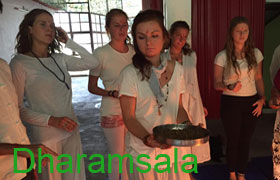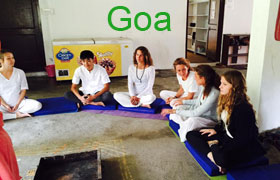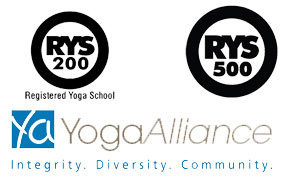Asanas that Strengthen Abdomen (Stomach)
Supt Vajrasana
Procedure
1. It is the advanced version of vajrasana. Thus you should start by sitting in vajrasaan.
2. Now hold both of your feet with your hands and lie down on your back with the support of your elbows.
3. Keep both of your elbows on the floor and palms on your stomach.
4. Finally take the support of your hands and elbows to get up and sit in the posture of vajrasana.
Benefits
1. It has all the benefits of vajrasana along with being highly beneficial for back ache.
2. It is very useful for sciatica and high blood pressure.
3. It is good for navel related issues too.
Precautions
1. People who cannot practice vajrasana shuld not practice this asana too.
2. You should not do this asana if you have undergone any surgery in your knees.
Pashchimottanasana
Procedure
1. Sit in the posture of dandasana.
2. Inhale and raise both of your hands upwards.
3. While exhaling, bend forward and hold your toe with your thumb and index fingers of both of your hands.
4. Keep your elbows on the floor and bring your body between your knees.
5. Pause in this posture as long as you can. Then raise your body and hands gradually while inhaling. Then relax in upavisht vishramasana.
Benefits
1. It is a unique and miraculous asana.
2. This asana aids in awakening kundalini Shakti. Thus it brings a spark into your body and your face which gives them a divine glow.
3. It is helpful for students as it improves the memory of their brains.
4. It is useful for dealing with obesity, diabetes, asthma and indigestion.
5. It alleviates egoism and makes your spinal cord flexible.
6. Helpful in semen disorders. It is also helpful in growing height.
Precautions
This asana should be prohibited in the cases of hip pain, neck pain and heart problem.
Purvottanasana
Procedure
1. Sit down in the posture of dandasana. Inhale and raise your body upwards.
2. Turn your head backwards. Pause in this posture as long as you can and revert back to dandasana.
Benefits
1. This asana makes your hands and shoulders stronger.
Precautions
You should not practice this asana if you have undergone any surgery in your shoulders.
Uttheeth Paschimottanasana
Procedure
1. Sit in the posture of dandasana. Join both of your feet and bring them towards your hips.
2. Hold your toe with the thumb and the index finger of your hand and raise it upwards.
3. Try to place your head between both of your knees.
4. After a while drop your hand and leg down gradually and revert to dandasana.
Benefits and Precautions
Same as that of Pashchimottanasana.
Akarna Dhanurasana – A
Procedure
1. Sit in the posture of dandasana. Lean over and hold your left toe with your left hand and your right toe with your right hand.
2. Try to pull your right leg and make it touch your ear.
3. Pause for a while in this posture and revert to the original state. Then repeat the same procedure with the other leg.
Benefits
1. It is helpful in asthma, cough and indigestion.
2. It is helpful in correcting the irregular periods.
3. It improves the functionality of chest, lungs and stomach.
4. It is good for shoulders and arthritis.
Precautions
This asana should not be practiced in case of cervical, lumbar spondylitis, slip disc and high blood pressure.
Akarna Dhanurasana – B
Procedure
1. Sit in the posture of dandasana and place your left leg on your right leg.
2. Hold your left toe with your right hand and your right toe with your left hand.
3. Try to pull your left leg with your right hand and make it touch your right ear.
4. Pause in this posture for a while and revert to the normal state. Repeat the process with the other leg too.
Benefits and Precautions
Samae as that of Akarna Dhanurasana – A
Simhasana
Procedure
1. Sit down in the posture of vajrasana.
2. Lift your hip slightly and place your right ankle and feet on your left leg.
3. Sit over both of your ankles. Place you right hand over your right knee and your left hand on your left knee.
4. Breathe through the mouth allowing the sound out. Get the tongue out as much as possible.
5. Repeat it for three or four times and revert to normal state.
Benefits
1. This asana stretches the muscles of your neck.
2. Makes your thyroid gland healthier.
3. Improves the efficiency of laryngeal and respiratory system.
4. It is good for the facial skin, eyes and nose. It keeps your body active.
Precautions
This asana can be practiced by everyone.
Ardha Mastyendrasana
Procedure
1. Sit in the posture of dandasana. Bend your right leg and place the ankle adjacent to your thigh.
2. Fold your left leg and place your feet over your right knee.
3. Move your right hand across your left leg and hold your left feet.
4. Take your left hand behind your back and look towards your back.
5. Pause in this posture as long as you can and revert to the original state.
Benefits
1. Highly beneficial for indigestion and diabetes.
2. Helpful for back ache, cervical and spondylitis.
3. Highly influential on pancreas.
Our yoga teacher training in India is well known throughout the world for its ability to turn a novice yoga seeker into an expert yoga trainer.




